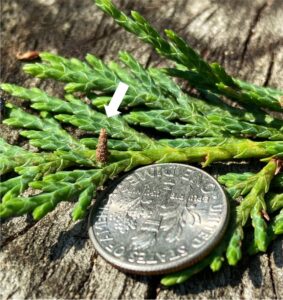
Days-old bagworm = critical management target – T. Waller – RCE
Bagworms should begin hatching NOW through – 4 weeks in NJ, beginning in the southern regions. Now is an optimal time to get this pest on your radar and prepare materials or approaches to attack first/second instar caterpillars. The control window for this pest is typically between 600-900 GDD50 when they begin to hatch and become airborne, i.e. the “ballooning” phase. It is important to check for egg-hatch prior to applications for greatest chemical efficacy, and to continue scouting as they often hatch and develop at asynchronous rates.
It is critical to target these insects EARLY!
Bagworm management – mechanical: If eggs have not hatched: hand-remove sacs/bags. Typically female/egg filled sacs are higher in the canopy so keep that in mind while scouting. This removes the problem from the field or landscape.
Treatment options for Lepidoptera (caterpillars) to have at the ready – containing: B.t. (Bacillus thuringiensis), spinosad , bifenthrin ), cyfluthrin, carbaryl, chlorantraniliprole, cyclaniliprole, cyclaniliprole + flonicamid, Lambda-cyhalothrin, cyantraniliprole, Indoxacarb. NOTE – Lethal pesticide doses are important, as sub-lethal doses can trigger early pupation, making the pest all but invincible to chemical or biological treatments. Follow label exactly.
IT IS CRITICAL TO ROTATE MATERIALS (Rotate between IRAC groups)
DISCLAIMER: The label is the law, always refer to it for allowable host crops, use-restrictions, application rates, reapplication intervals, re-entry intervals (REI), and mix compatibility information. Production and pesticide information on this site are for private/commercial pesticide applicators and landscape professionals only, and are NOT for home gardener use. Provided materials represent examples and do not cover all possible control scenarios. Please contact your local agent or chemical sales representative for more information or to discuss additional pest management options.
| BAGWORMS (600-900 GDD) (Bagworm hatch prediction as of 5/24/23) | ||||||
| Crop type | Common Name | Scientific Name | GDD Min (50F) | GDD Max (95F) | Reference | Developmental / Target Stage |
| Conifer mostly, many minor hosts | Bagworm | Thyridopteryx ephemeraeformis | 600 | 900 | RU | Larvae (early instars) – ONLY CONTROL WINDOW |
| Region | Location | Station | Date (600 GDD) | Date (900 GDD) | *Treatment window | *Bagworm Hatch – Predictions only, SCOUTING is critical! Treat as soon as larvae detected. |
| South | Upper Deerfield | NJ50 | 31-May | 14-Jun | 14 days | |
| Central | Howell / Freehold | NJ10 | 9-Jun | 23-Jun | 14 days | |
| North | High Point | NJ59 | 15-Jun | 2-July | 17 days | |
Please download and print the Rutgers Nursery and Landscape Pest Scouting Guide or Conifer and Christmas Tree Pest Scouting Guide and refer to this post “Obtaining your local growing degree-days (GDD)” for additional information. (See pest scouting guides for complete list of references – cited within lists below)
Please SHARE what you SEE!! If you see a pest, disease, otherwise interesting or troublesome issue please report it to the Working Group by following the QR Code on the front of the Pest Scouting Guides or by filling out this reporting form.
